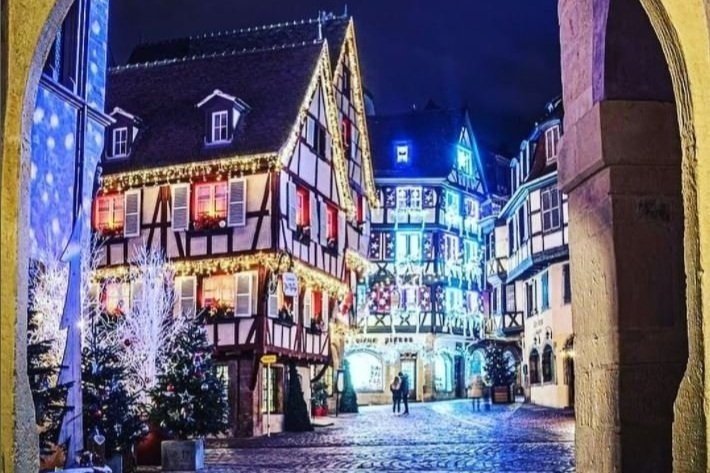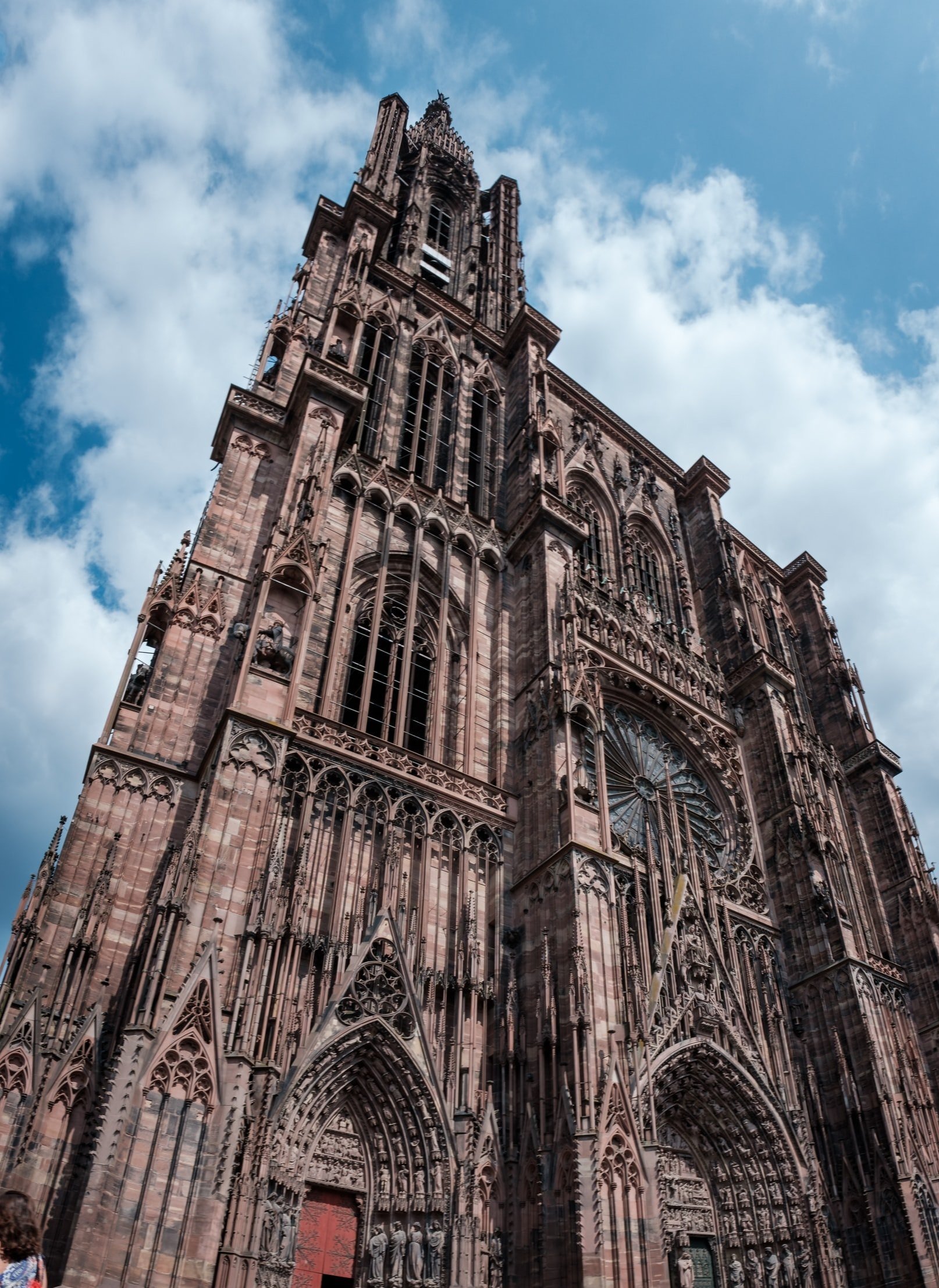Our First Christmas in France
As far back as I can remember, I've always loved Christmas, and I've always loved everything about it. From putting out the lit-up Frosty the Snowman in our yard (whether 20 or 80 degrees in Mississippi) to helping my grandmother paint Nativity scenes, it's been a time of wonder and color for me. Yet now, I love what it means - in December, January, or June - that light has arrived into all our darkness. And all our darkness or that of the entire world will never put it out. Light has come to us, and in that light is Life. I love the narratives of Christmas - from a Christmas Carol to A Christmas Story, but ultimately to the narratives found in the gospels of Matthew and Luke.
You could say: why talk Christmas in mid-January? First, re-read above: Christmas is a complete passion of mine. Second, we're late at everything this year. Third, which I only discovered recently, many around the world keep the tradition of Christmas ending on Candlemas, which falls on February 2nd. Just as Epiphany on January 6th commemorates the Wise Men, February 2nd celebrates Jesus' presentation at the temple to Simeon and Anna (Luke 2:22-40). Read below for a bit more on this.
So our Christmas tree is down (yes, it was live this year, so we had no choice), but Christmas music is still on.
Every Christmas of my life, except one, has been spent in Mississippi. The other was in tropical Australia. This year was different as we are in France, and we did our best to make the most of it.
Different it was. I've always made an effort to have our fake Christmas tree assembled before Thanksgiving, that is mid-November for non-Americans. Not fully decorated but lit. This year, while the tree was live, it was my smallest tree ever - not Charlie Brown size, but close. Our first ornament was hung on December 19th - yes, I was counting the days. Decorations on the tree and in our home were sparse. We remained so busy with life adjustments that we had little time for presents. Thankfully our boys' grandparents, aunts, and uncles came through big time.
Finally, our oldest qualified to compete in the French National Championships for swimming for his age group. While we were (and are to this day) proud of him, it put he and his mom out of touch in Rennes, France until Dec 23rd. After arriving home from the 5-day competition right before Christmas, they made as much time possible for their most precious priority - not Christmas decorations, but sleep.
Thus, our Christmas at home was a mere blip, a stark contrast from our life in the United States. So we decided the best gift we could give one another was a family trip in France over the holiday.
We traveled to Alsace, a region in the east of France bordering Germany. Alsace was actually part of Germany until 1918, at the end of the first World War. Much of it feels German, except they speak French. However, some French told me they really don't speak French at all in Alsace. Many Germanic traditions are still in place, from brats to beer. The people look different too, from complexion to hair color to build. This is no longer Latin France. Most notably, an Alsatian Christmas is known for its huge and beautiful Christmas markets, markets that take over cities and villages throughout December and well into the new year.
Colmar is known to be "the Soul of Christmas." Three days in its Christmas markets, half-timbered houses with Christmas decor at every turn, a toy museum (where I got to play the original Nintendo again - Zelda & Super Mario), pints of beer sloshing around win-stubs (wine bistros), Tarte flambées (very thin pizzas) crispy from the embers of a hot brick oven, a sprawling neighboring castle built in the 12th century, and an outdoor ice skating rink - we could not agree more. It was as if we were strolling through a child's fairy tale book.
What are we building in our lives?
Neighboring Strasbourg is more cosmopolitan, thus claiming itself to be "the Capital of Christmas." Again, good fit and nice touch. While the cities differ, they both, to paraphrase Dickens himself, "keep Christmas well." A Christmas market created in 1570, buildings are lit up in a glorious range of colors, with every window in every establishment having a sled, a reindeer, a St. Nick, a lit tree, a Christmas teddy bear, or some combination perched upon it. Every kid, from 1 to 92 and beyond, are captive to the spirit of the season.
More important than what we did, this trip and this time made me think of or consider 3 specific things about Christmas.
First, the majestic and towering structure of the Strasbourg Cathedral. People were working on it from 1015 to 1439. Completed, it's been described by Victor Hugo as a "gigantic and delicate marvel" and by Goethe as a "sublimely towering, wide-spread tree of God." Over its history, it's been both Catholic and Protestant. John Calvin did preach there. It was the world's tallest building for 227 years (1647-1874) and today is the sixth-tallest church in the world. In World War 2, the Nazis removed the Cathedral's large stained glass, storing it in 74 cases in Germany. These pieces were found and returned to the cathedral by the Monuments Men of the U.S. military.
We can say things about such cathedrals, as how they are now more tourist attractions than churches. Yet, when visiting, you are struck with a sense of awe - that so many people, over so much time, in multiple lifetimes, gave their lives to constructing it and keeping it - and you wonder why? You want to think for the glory of God. I'm sure there were other motives. But to build something that beautiful and majestic, an expansive work of art, and for so many to use their gifts to do so, is inspiring. It has remained, for others to wander to it and wonder upon it.
A graduate school teacher told one of my classes - "my generation built the skyscrapers, yours must build the cathedrals." That has always stood out. What are we building? What are we giving our lives to? The structures we create in our lives are not just something others should see, but it's something others should use to consider. How are we using our gifts to build something meaningful, lasting, and worthwhile? What are we building that will stand the test of time or even eternity?
A foot in two worlds
Second, I've thought much about Alsace itself. A region in France, yet with Germanic origins, roots, and traditions. A mixture and combination of each. The people living there have a foot in both cultures. It made me think of those of us who are Christians, having a foot in both worlds. Or as Augustine put it, living in two cities - the city of man and the city of God. To be in this world and not of it.
This goes back to an age-old question for Christians - how should we live in the here and now of this world - when as CS Lewis said - "we are meant for another world." The French in Alsace keep their German traditions, yet they are now of another culture too, of another country. I think about that as a Christian - living in one world, and trying to do well - yet now being part of another world, where all things are being made new.
What traditions do we keep? What do we let go of? What world, or country, do we represent or do others see in us? Ultimately, we are to be a new people, with a new citizenship, to live out a vision of the life God desires for this world.
Transformed by Great Art
This leads to my third and most important point about this trip for me. Here again, I go back to art. Only it's not a building I am speaking of, it's a painting. Actually, it's two paintings. In Colmar, there is the Unterlinden Museum. Within it, there is a series of paintings, by Matthias Grunewald, depicting the life of Christ. They are well known by many, yet I was not aware of them. I'm glad I finally discovered it.
Together, this series of paintings was designed as an altarpiece and made for a monastery that in its time (early 1500s) was a hospital, caring for people suffering from plagues. They were meant to show patients Jesus understood and shared their afflictions. Two of the paintings caught my attention. The first is of the death of Christ on the cross. You see His agony, you see His mother, weeping at the foot of the cross, with John the disciple. You see Jesus suffering and dying.
Then, you walk behind the painting of the crucifixion to - literally - the other side. There you see or perhaps behold, a painting of the resurrection. I have never seen a painting, or any other work of art, like it. The artist did everything he could, as a limited human being, to capture and do justice to the resurrection of Christ. It is so striking, so different, so otherworldly, that I received a gift of coming a little closer to what the actual resurrection might have been like. The closest I've come to it was being in Jerusalem at the site thought to be the empty tomb. That is what great art can do. It transports you. It helps you see everything in a different light.
There are very few paintings of the resurrection, and if you think about it, for good reason. What did it look like? What did He look like? Even at our best, we are limited in our scope and understanding. Some have said that is why the early church was so different - they saw it, with their own eyes. They saw Him. Yet seeing that painting, that image, made me think, made me know again - if that is true, if that happened, as Christians say and believe it did, then it changes everything! Everything. And it really does.
I needed to see it. For the first time, or again. In a time of pandemic fatigue, we need to remember anything is possible, and nothing is more important than light in darkness that brings new life. We can't have the resurrection without Christmas, and we can't have Christmas without the resurrection. To begin our new year reflecting on the newness always available to us, to see and be transformed by art, was the best gift I received my first Christmas in France.
John Hugh serves with GlobalGrace in France




